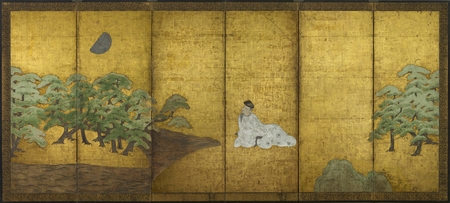Product Description
7203 A six-fold paper screen painted in ink and colour on a gold ground depicting Kakimoto no Hitamaro gazing at the moon and sitting on the shore of Kei no Matsubara
Japan 17th century Momoyama/Edo period
Dimensions: H. 67¾” x W. 148½” (172cm x 377cm)
Hasegawa school
The Hasegawa School was founded by Hasegawa Tōhaku (1539-1610) in the late 16th century. Despite being small, consisting mostly of Tōhaku, his sons and sons-in-law it is known today as one of the most influential artistic groups of the period. Its members conserved Tōhaku’s quiet and reserved aesthetic, which many attribute to the influence of Sesshū Tōyō (1420-1506) as well as his contemporary and friend, Sen no Rikyū (1522-1591).
Kakinomoto no Hitomaro (662-710) was a Japanese waka poet and aristocrat of the late Asuka period (538 to 710). He was the most prominent of the poets included in the Manyōshū (Poetry Collection of Ten Thousands Leaves) compiled in the middle of the eight century, the earliest surviving anthology of Japanese poems.
Hitomaro was born to the Kakinomoto clan, an aristocratic court family responsible for preserving and reciting the oral history of Japan to the court. Having grown up under the artistic influence of previous generations Hitomaro excelled as a poet. He is believed to have begun working at the court in 680 under Emperor Temmu (631-686) and continued to serve under Empress Jitō (645-703) when it is generally considered that he flourished. He also spent time in government service in several places away from the capital giving him the opportunity to compose poetry praising the Japanese landscape.
One of the Sanjyurokkasen (thirty-six immortal poets) Hitomaro has always been held in high regard with continuing fame until the present day. Being the most famous of all the 36 poets, images depicting him were often produced as an inspiration for other aspiring poets. This iconic image of a bearded man leaning on an armrest looking up to the right became a standard representation. This screen depicts the poet in his classic pose contemplating the moon from the shores of Kei no Matsubara; a scenic landscape on Awaji Island which gained great fame after Hitomaru’s poem:
Kehi no umi
niwa yoku arashi
karikono no
midarete izimiyu
ama no tsuribune
The sea at Kei
must be a good place to harvest.
For like reeds cut free
they float in confused array-
those boats of the fishermen
A scroll dating to the 13h century attributed to Fujiwara Nōbuzane (1162-1241) depicting Hitomaro in his classic pose can be found in the collection of Kyoto National Museum (Ref. no. A kō 14)






